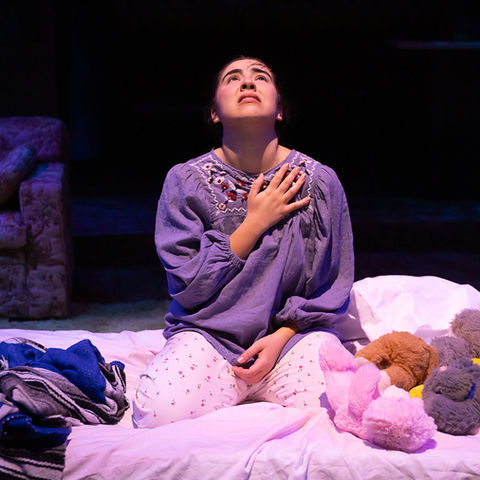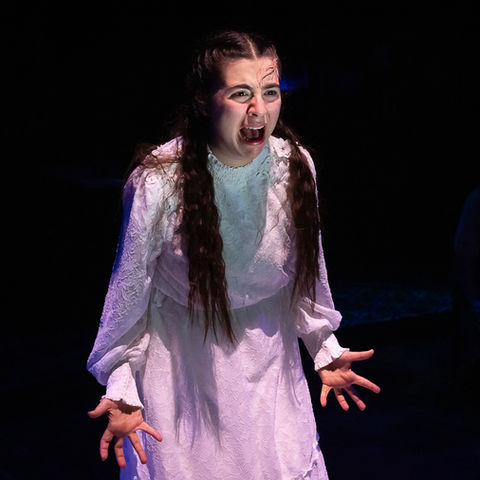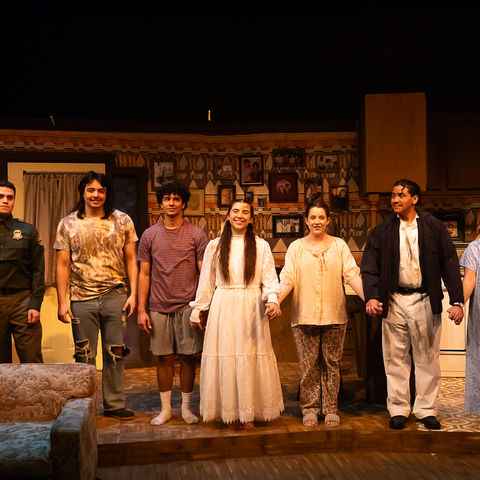FABRICE CONTE-WILLIAMSON
THEATRE DIRECTOR & EDUCATOR
LYDIA
Sam Houston State University
2025
Lydia
by Octavio Solis
Directed by Fabrice Conte-Williamson
Assistant Director: Zarina Garza
Scenic Design and Props: Emily Childs
Lighting Design: Eric Marsh
Costume Design: Isabella Bozo
Sound Design: Ellie Hand
Stage Manager: Ellie King
Fight Choreography: Kevin Crouch
Intimacy Direction: Vicky Lantz
Photo credit: Lynn Lane and David Rios
Sam Houston State University (2025)


DIRECTOR'S NOTE
In Lydia, Octavio Solis paints the complex portrait of a mixed-status Mexican American family living in El Paso, TX in the early 1970s. Rosa Flores, the matriarch, left Mexico for the United States—with dreams of a better life for her family—to give birth to her eldest son Rene. Soon thereafter, Claudio, her husband, crossed the border to join them. Then their daughter Ceci was born, and finally, Misha, their youngest son.
At the heart of Lydia is the question of shifting identities, which animates all of its characters. The Flores family, now firmly planted on the northern side of the US-Mexico border, lives a life that Rosa proudly describes as “quasi middle-class.” She yearns to be American, driven by the deep desire for assimilation that characterizes many immigrants. She works a government job, she shops at the mall, and she abandons her Catholic faith to join an Evangelical church. Claudio, on the other hand, longs for his Mexican roots and the life that could have been on the other side of the border. He works a grueling shift as a night cook and spends his days sleeping and listening to old ranchera music. Perhaps his own life has been sacrificed for the sake of his children’s future.
Rene, a troubled 19-year-old, agonizes while awaiting his draft notice as the Vietnam War drags on. Alvaro, Rene’s older cousin, has recently returned home after his deployment and appears to be a changed man. Rene struggles to understand Alvaro’s new outlook on life and deals with his own angst through physical and emotional violence.
Ceci, confined to a mattress in the middle of the Flores’ living room, suffers from severe brain damage after a mysterious car accident three days before her quinceañera. Her condition has greatly affected her mobility and her ability to speak. No longer a child but not quite an adult, Ceci seems frozen in time at the threshold of her “señorita-hood,” watching cartoons on television in the sole company of her many stuffed animals. Her brother Misha, an aspiring poet, doesn’t fit in at school for he is more interested in daydreaming than football. The simultaneous coming-of-age of Ceci and Misha serves as an emotional throughline for the play. The siblings stand impatient at the border of their sexual awakening, burning with a desire they fail to fully understand.
The life of the Flores family changes abruptly when Rosa hires Lydia, a young woman from Jalisco, to serve as their maid. Lydia’s surprising ability to understand Ceci and verbalize her needs unsettles everyone and will ultimately force the family to confront their deepest and darkest secrets.
Solis’ play immerses the audience in the dissonance of a bilingual household, with characters codeswitching between English, Spanish, and Spanglish, thereby isolating those who cannot easily navigate between the languages. Language, of course, represents more than the ability to communicate effectively. For Rosa and Lydia, mastering English means unquestionable integration. It is the key to being perceived (and to perceive themselves) as truly American, the key to a future in the United States. For Claudio, English is a barrier that has condemned him to near permanent silence, an inescapable reminder of his otherness. On the other hand, Rene and Misha, like many first-generation Americans, understand but speak little of their parents’ first language—an example of receptive-bilingualism. Language is also a form of freedom for Misha. He expresses the complex emotions of adolescence in the poems he writes in his notebook, each page like a mirror that reflects his transformation from boy to young man.
Although Lydia takes place more than half a century ago, its themes appear as relevant as ever: the pursuit of the American dream, the harsh realities of immigration, and the unforgiving demands of assimilation. What does it mean to be American? For some, it is the ultimate sacrifice—“flag-draped Chicanos” giving their lives for “Tío Sam,” eager to wear the army uniform as a means to earn their place in the United States.
When the play opens, Ceci describes her family as “sad and wounded cause of somethin’ that broke.” Each character seems suspended at the edge of their own great precipice. It becomes clear that all occupy a tenuous position on different physical, cultural, emotional, and spiritual borders. Determined to mend those she loves, Ceci vows to recall what happened the night of the fatal car accident: “what happened to me, porque no puedo remember, I must remember."















